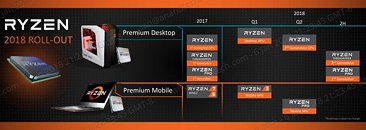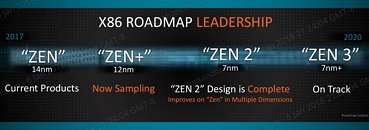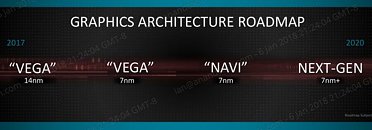Monday, January 8th 2018

AMD Reveals CPU, Graphics 2018-2020 Roadmap at CES
AMD at CES shed some light on its 2018 roadmap, while taking the opportunity to further shed some light on its graphics and CPU projects up to 2020. Part of their 2018 roadmap was the company's already announced, across the board price-cuts for their first generation Ryzen processors. This move aims to increase competitiveness of its CPU offerings against rival Intel - thus taking advantage of the blue giant's currently weakened position due to the exploit saga we've been covering. This move should also enable inventory clearings of first-gen Ryzen processors - soon to be supplanted by the new Zen+ 12 nm offerings, which are expected to receive a 10% boost to power efficiency from the process shrink alone, while also including some specific improvements in optimizing their performance per watt profile. These are further bound to see their market introduction in March, and are already in the process of sampling.
On the CPU side, AMD's 2018 roadmap further points towards a Threadripper and Ryzen Pro refresh in the 2H 2018, likely in the same vein as their consumer CPUs that we just talked about. On the graphics side of their 2018 roadmap, AMD focused user's attention in the introduction of premium Vega offerings in the mobile space (with HBM2 memory integration on interposer, as well), which should enable the company to compete against NVIDIA in the discrete graphics space for mobile computers. Another very interesting tidbit announced by AMD is that they would be skipping the 12 nm process for their graphics products entirely; the company announced that it will begin sampling of 7 nm Vega products to its partners, but only on the Instinct product line of machine learning accelerators. We consumers will likely have to wait a little while longer until we see some 7 nm graphics cards from AMD.Jumping to AMD's 2020 plans, there are some very interesting developments. At its Tech Day presentation at CES, AMD has confirmed that their Zen 2 design on the 7 nm process has been already completed. The lack of Zen 2 mentions in the 2018 roadmap means this particular piece of silicon will only be launched after 2019, but with the company having already announced that the base processor design is complete - with some deeper changes than those introduced by Zen+ - means AMD will have some time now to further tune and update its final design according to the 7 nm process' characteristics. AMD has also announced that their next update to the Zen architecture, Zen 3 on the 7 nm+ process, is on-track for 2020 (likely 4Q, or beyond), which at this point, likely means the company has planned out how and where they want to go with further improvements to the Zen architecture.On the graphics side, the 2020 roadmap includes the aforementioned cut of the 12 nm process from AMD's graphics architecture. Instead, the company will jump from the 14 nm process currently used on its Vega dies straight to the 7 nm process, beginning with the lower volume, higher margin Instinct accelerator line. Considering that these are expected to be sampled in late 2018, it's likely AMD will introduce it to market in 2019 already. The shrinkage of Vega to 7 nm is likely a way for AMD to learn the ropes of developing for that process, without also having to design a new graphics architecture at the same time, thus saving them some valuable engineering resources that can be fully deployed in the shrinking process, and then on the design/redesign of some Navi features for the 7 nm manufacturing process.After that, the roadmap only mentions the introduction of Navi (if it follows the other 2020 roadmaps by AMD, this also points towards a 2019 introduction), and an (expected) late 2020 next-gen, 7 nm+ post-Navi graphics architecture.
Source:
AnandTech
On the CPU side, AMD's 2018 roadmap further points towards a Threadripper and Ryzen Pro refresh in the 2H 2018, likely in the same vein as their consumer CPUs that we just talked about. On the graphics side of their 2018 roadmap, AMD focused user's attention in the introduction of premium Vega offerings in the mobile space (with HBM2 memory integration on interposer, as well), which should enable the company to compete against NVIDIA in the discrete graphics space for mobile computers. Another very interesting tidbit announced by AMD is that they would be skipping the 12 nm process for their graphics products entirely; the company announced that it will begin sampling of 7 nm Vega products to its partners, but only on the Instinct product line of machine learning accelerators. We consumers will likely have to wait a little while longer until we see some 7 nm graphics cards from AMD.Jumping to AMD's 2020 plans, there are some very interesting developments. At its Tech Day presentation at CES, AMD has confirmed that their Zen 2 design on the 7 nm process has been already completed. The lack of Zen 2 mentions in the 2018 roadmap means this particular piece of silicon will only be launched after 2019, but with the company having already announced that the base processor design is complete - with some deeper changes than those introduced by Zen+ - means AMD will have some time now to further tune and update its final design according to the 7 nm process' characteristics. AMD has also announced that their next update to the Zen architecture, Zen 3 on the 7 nm+ process, is on-track for 2020 (likely 4Q, or beyond), which at this point, likely means the company has planned out how and where they want to go with further improvements to the Zen architecture.On the graphics side, the 2020 roadmap includes the aforementioned cut of the 12 nm process from AMD's graphics architecture. Instead, the company will jump from the 14 nm process currently used on its Vega dies straight to the 7 nm process, beginning with the lower volume, higher margin Instinct accelerator line. Considering that these are expected to be sampled in late 2018, it's likely AMD will introduce it to market in 2019 already. The shrinkage of Vega to 7 nm is likely a way for AMD to learn the ropes of developing for that process, without also having to design a new graphics architecture at the same time, thus saving them some valuable engineering resources that can be fully deployed in the shrinking process, and then on the design/redesign of some Navi features for the 7 nm manufacturing process.After that, the roadmap only mentions the introduction of Navi (if it follows the other 2020 roadmaps by AMD, this also points towards a 2019 introduction), and an (expected) late 2020 next-gen, 7 nm+ post-Navi graphics architecture.




41 Comments on AMD Reveals CPU, Graphics 2018-2020 Roadmap at CES
o_Oo_Oo_O
Let's just hope their CPU keeps going as it does, because they'll need it. Desperately.
Fuck you AMD, you have screwed up the whole plan once more.
I hope I'm wrong
Hope that helps to explain.
7nm will shrink the existing products to 1/2 the size and power, but we need atleast double the Stream Processors for a meaningful upgrade.
Shrinking Vega won't close that gap at all, its quite worrying.
I recently bought 4x 580's easily without any problems. Pair 'm up and they beat a 1080 with a slight higher power consumption (~ 300W). But i use 'm for mining with a lowered clock/tdp and all.
I'd like to see the Ryzen+, Then on top of that what they will do with Threadripper.